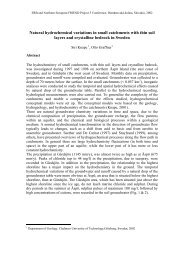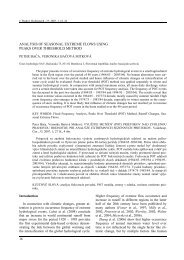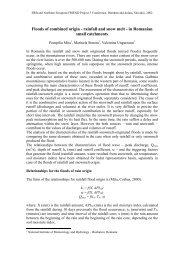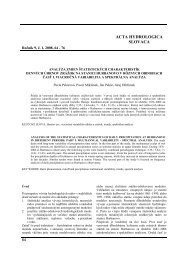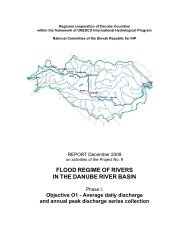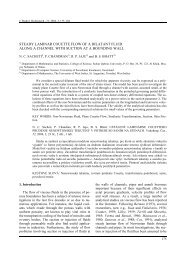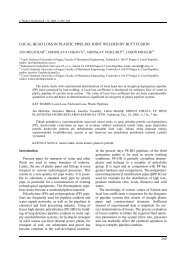Data acquisition and processing in a small debris flow prone ...
Data acquisition and processing in a small debris flow prone ...
Data acquisition and processing in a small debris flow prone ...
Create successful ePaper yourself
Turn your PDF publications into a flip-book with our unique Google optimized e-Paper software.
ERB <strong>and</strong> Northern European FRIEND Project 5 Conference, Demänovská dol<strong>in</strong>a, Slovakia, 2002<br />
Abstract<br />
<strong>Data</strong> <strong>acquisition</strong> <strong>and</strong> <strong>process<strong>in</strong>g</strong> <strong>in</strong> a <strong>small</strong> <strong>debris</strong> <strong>flow</strong> <strong>prone</strong><br />
catchment<br />
M. Arattano 1 , L. Marchi 2 , A.M. Deganutti 2<br />
The Moscardo Torrent is a <strong>small</strong> creek, with an area of about 4 km 2 , located <strong>in</strong> the<br />
Eastern Italian Alps (Fig. 1). The bedrock of the Moscardo bas<strong>in</strong> is made of Carboniferous<br />
flysch, consist<strong>in</strong>g of shale, slates, siltstone, s<strong>and</strong>stone <strong>and</strong> breccia that<br />
cont<strong>in</strong>uously outcrop <strong>in</strong> the upper portion of the bas<strong>in</strong> <strong>and</strong> locally along the torrent.<br />
Fig. 1 - The Moscardo Torrent bas<strong>in</strong> <strong>and</strong> its alluvial fan. 1: <strong>debris</strong> <strong>flow</strong><br />
<strong>in</strong>itiation site; 2: ra<strong>in</strong>gauges; 3 <strong>and</strong> 4: <strong>in</strong>strumented channel stretches.<br />
The poor mechanical properties of the rocks, the <strong>in</strong>stability caused by the presence<br />
of a deep seated gravitational slope deformation <strong>and</strong> the steepness of the upper bas<strong>in</strong><br />
slopes facilitate frequent widespread falls <strong>and</strong> toppl<strong>in</strong>g of rocks. The very large quantity<br />
of <strong>debris</strong> that reaches the dra<strong>in</strong>age network by gravitational <strong>and</strong> erosion processes <strong>and</strong><br />
by snow avalanches expla<strong>in</strong>s the strong tendency of the Moscardo Torrent to generate<br />
<strong>debris</strong> <strong>flow</strong>s <strong>and</strong> hyperconcentrated <strong>flow</strong>s. The <strong>debris</strong> <strong>flow</strong>s of the Moscardo Torrent<br />
led to the construction of a huge fan that progressively <strong>in</strong>vaded the receiv<strong>in</strong>g valley<br />
bottom forc<strong>in</strong>g the receiv<strong>in</strong>g stream to <strong>flow</strong> on the opposite side of the valley floor. The<br />
1 1CNR-IRPI, Strada delle Cacce 73, 10135 Tor<strong>in</strong>o, Italy E-mail: m.arattano@irpi.to.cnr.it.<br />
2 CNR IRPI, Corso Stati Uniti 4, 35127 Padova, Italy E-mail: lorenzo.marchi@irpi.pd.cnr.it
ERB <strong>and</strong> Northern European FRIEND Project 5 Conference, Demänovská dol<strong>in</strong>a, Slovakia, 2002<br />
ma<strong>in</strong> morphological parameters of the bas<strong>in</strong> closed at the fan apex are listed <strong>in</strong> Table 1;<br />
the length of the channel reach on the fan is about 1000 m (Arattano et al., 1997).<br />
The Moscardo <strong>debris</strong> <strong>flow</strong>s are composed by material of a wide range of dimensions.<br />
Lateral levees <strong>and</strong> <strong>debris</strong> <strong>flow</strong> lobes are mostly formed by <strong>small</strong> <strong>and</strong> medium boulders;<br />
larger boulders of over two meters are also common. Gra<strong>in</strong> size analyses have been<br />
carried out on several matrix samples (Arattano et al., 1997, Moscariello <strong>and</strong> Deganutti,<br />
2000) from old <strong>and</strong> fresh deposits. The high percentage of f<strong>in</strong>e particles <strong>in</strong> the matrix<br />
(from 13 to 35% less than 40 µm) underl<strong>in</strong>es the muddy character of the Moscardo<br />
<strong>debris</strong> <strong>flow</strong>s.<br />
Table 1. Ma<strong>in</strong> morphometric parameters of the Moscardo bas<strong>in</strong>.<br />
Bas<strong>in</strong> area<br />
[km 2 ]<br />
Maximum<br />
elevation<br />
[m]<br />
M<strong>in</strong>imum<br />
elevation<br />
[m]<br />
Average<br />
bas<strong>in</strong> slope<br />
[%]<br />
Channel<br />
length [km]<br />
Average<br />
channel slope<br />
[%]<br />
4.1 2043 890 63 2.76 37<br />
The Moscardo <strong>debris</strong> <strong>flow</strong> material has been studied also from the rheological po<strong>in</strong>t<br />
of view, us<strong>in</strong>g a large amount of material sampled from a fresh deposit left by a <strong>debris</strong><br />
<strong>flow</strong> occurred on July, 5 1995. Several suspensions, obta<strong>in</strong>ed mix<strong>in</strong>g the material with<br />
water, were analysed for a range of different solid concentrations us<strong>in</strong>g two parallel<br />
plates rheometers <strong>and</strong> a tilt<strong>in</strong>g plane. The material showed a shear th<strong>in</strong>n<strong>in</strong>g viscous<br />
behaviour which can be well represented by a Herschel-Bulkley model (Coussot et al.,<br />
1998).<br />
This bas<strong>in</strong> was chosen <strong>in</strong> 1989 by the Research Institute for Hydrogeological Protection<br />
of the Italian National Research Council (CNR IRPI) for the <strong>in</strong>stallation of a <strong>debris</strong> <strong>flow</strong><br />
monitor<strong>in</strong>g system. This latter consisted of two ultrasonic sensors, placed at a distance<br />
of about 300 m on the fan. A ra<strong>in</strong>gauge was also <strong>in</strong>stalled <strong>in</strong> the upper portion of the<br />
bas<strong>in</strong>. In 1995, thanks to the fund<strong>in</strong>gs of a European Project, the ultrasonic sensors<br />
<strong>in</strong>stalled <strong>in</strong> 1989 were replaced by new ones <strong>and</strong> a third ultrasonic sensor was added<br />
150 m upstream of these latter. A fixed video camera was positioned close to the<br />
<strong>in</strong>termediate of the three ultrasonic sensors <strong>and</strong> a network of four seismic detectors was<br />
set up about 1 km upstream from the ultrasonic gaug<strong>in</strong>g stations. F<strong>in</strong>ally, <strong>in</strong> 1997,<br />
a second ra<strong>in</strong>gauge was <strong>in</strong>stalled <strong>in</strong> the centre of the bas<strong>in</strong> <strong>and</strong> two new seismic sensors<br />
were set up close to the <strong>in</strong>termediate ultrasonic gauge on the fan.<br />
From 1990 to 1998, 15 <strong>debris</strong> <strong>flow</strong>s occurred, 14 of which were recorded by the<br />
<strong>in</strong>stalled gauges. Several types of measurements have been carried out on the recorded<br />
<strong>debris</strong> <strong>flow</strong>s dur<strong>in</strong>g the years, <strong>in</strong>clud<strong>in</strong>g mean front velocity, surface velocity, volume,<br />
<strong>flow</strong> stage, hydrograph deformation, trigger<strong>in</strong>g ra<strong>in</strong>falls etc..<br />
The ultrasonic sensors measure the torrent stage, mak<strong>in</strong>g it possible to record the <strong>debris</strong><br />
<strong>flow</strong> hydrographs. A time lag of 60 seconds was <strong>in</strong>itially set between two consecutive<br />
record<strong>in</strong>gs of the ultrasonic sensors. This time lag was then reduced to 10 seconds <strong>in</strong><br />
1990, to grant a better accuracy of the data, <strong>and</strong> further reduced to 1 second <strong>in</strong> 1995,<br />
thanks to the updat<strong>in</strong>g <strong>and</strong> improvement of the record<strong>in</strong>g system mentioned earlier. The<br />
mean propagation velocity of the front can be calculated <strong>in</strong> the monitored reach as the<br />
ratio of the distance between the sensors to the time <strong>in</strong>terval between the appearance<br />
of the peak of the <strong>debris</strong> <strong>flow</strong> surge <strong>in</strong> the two recorded hydrographs. The analysis
ERB <strong>and</strong> Northern European FRIEND Project 5 Conference, Demänovská dol<strong>in</strong>a, Slovakia, 2002<br />
of the hydrographs recorded by the ultrasonic sensors may show the aggradation or<br />
degradation of the channel bed at the record<strong>in</strong>g sites. Flow stage measurements <strong>and</strong><br />
topographic survey of the monitored sections make it possible to estimate peak<br />
discharges <strong>and</strong> total volume of <strong>debris</strong> <strong>flow</strong>s (Arattano et al., 1997, Marchi et al., 2002).<br />
Debris <strong>flow</strong> volumes Vol have been estimated as:<br />
Vol<br />
t<br />
f<br />
∫ vA ( t ) dt = v ∫ A ( t ) dt<br />
(1)<br />
f<br />
=<br />
t 0<br />
t 0<br />
t<br />
where v is the mean velocity of the <strong>flow</strong>, which was assumed constant for the entire<br />
<strong>debris</strong> <strong>flow</strong> wave <strong>and</strong> equal to the mean front velocity, A(t) is the cross section area<br />
occupied by the <strong>flow</strong> at the time t, known from topographic surveys <strong>and</strong> the ultrasonic<br />
data, t 0 is the time of arrival of the surge at the gaug<strong>in</strong>g site <strong>and</strong> t f is the time at the end<br />
of the <strong>debris</strong> <strong>flow</strong> wave. Mean velocity of the ma<strong>in</strong> front was used for volume<br />
computation because it is the only velocity datum available for all recorded events:<br />
additional <strong>in</strong>formation on velocity variations dur<strong>in</strong>g the <strong>debris</strong> <strong>flow</strong> wave have been<br />
obta<strong>in</strong>ed only for two events. This approach to the computation of the <strong>flow</strong><strong>in</strong>g volume<br />
assumes that the material <strong>flow</strong>s through the considered section at a constant velocity<br />
dur<strong>in</strong>g the surge. Thus computed <strong>debris</strong> <strong>flow</strong> volumes should be regarded as<br />
approximate estimates.<br />
The seismic detectors (seismometers <strong>and</strong> geophones) record ground vibrations <strong>in</strong>duced<br />
by the passage of a <strong>debris</strong> <strong>flow</strong>. The purpose of the seismic sensors <strong>in</strong>stallation, <strong>in</strong> the<br />
<strong>in</strong>itial phase of the research, was essentially to verify which <strong>in</strong>formation could be<br />
obta<strong>in</strong>ed through this type of devices on the occasion of a <strong>debris</strong> <strong>flow</strong> occurrence.<br />
However, the first results that have been obta<strong>in</strong>ed showed the possibility of us<strong>in</strong>g these<br />
detectors also as tools for velocity measurements (Arattano <strong>and</strong> Moia, 1999). The <strong>debris</strong><br />
<strong>flow</strong> passage generates ground vibrations whose amplitude graph corresponds to the<br />
stage hydrograph. The ground vibrations peak is detectable by a seismic sensor placed<br />
at a safe distance of some tens of meters from the channel bed. The mean front velocity<br />
can be then measured plac<strong>in</strong>g a couple of these detectors at a known distance from each<br />
other along the torrent adopt<strong>in</strong>g the same procedure previously described for velocity<br />
measurements with ultrasonic sensors.<br />
A fixed video camera like that <strong>in</strong>stalled <strong>in</strong> 1995 on the alluvial fan of the Moscardo<br />
Torrent allows a visual <strong>in</strong>terpretation of the <strong>debris</strong> <strong>flow</strong> features. The video camera<br />
shoots slantwise a straight channel reach about 80 meters long <strong>and</strong> is triggered by the<br />
upstream ultrasonic sensor by means of a trigger<strong>in</strong>g software that identifies abrupt<br />
<strong>in</strong>creases of the stage <strong>in</strong> the torrent <strong>and</strong> starts the video record<strong>in</strong>gs. The possibility was<br />
also <strong>in</strong>vestigated of us<strong>in</strong>g the video record<strong>in</strong>gs for estimat<strong>in</strong>g <strong>debris</strong> <strong>flow</strong> surface<br />
velocity. A simple method to process the recorded images was developed that maps 2D<br />
image po<strong>in</strong>ts on the screen <strong>and</strong> po<strong>in</strong>ts <strong>in</strong> the 3D space (Arattano <strong>and</strong> Marchi, 2000).<br />
Average velocity of the features float<strong>in</strong>g on the surface was then computed as the ratio<br />
of their traveled distance to the time elapsed between the shoot<strong>in</strong>g of the video frames<br />
that conta<strong>in</strong>ed them. Average <strong>debris</strong> <strong>flow</strong> velocities estimated through image <strong>process<strong>in</strong>g</strong><br />
were consistent with measurements based on the record<strong>in</strong>gs of the ultrasonic gauges;<br />
velocity variations <strong>in</strong> <strong>debris</strong> <strong>flow</strong> waves are discussed <strong>in</strong> Arattano <strong>and</strong> Marchi (2000).<br />
The <strong>in</strong>strumentation <strong>in</strong>stalled <strong>in</strong> the Moscardo Torrent bas<strong>in</strong> (ra<strong>in</strong>gauges <strong>and</strong> sensors<br />
which detect <strong>debris</strong> <strong>flow</strong> passage) gives the possibility of analyz<strong>in</strong>g the relations<br />
between ra<strong>in</strong>storm characteristics <strong>and</strong> <strong>debris</strong> <strong>flow</strong> occurrence more precisely than
ERB <strong>and</strong> Northern European FRIEND Project 5 Conference, Demänovská dol<strong>in</strong>a, Slovakia, 2002<br />
usually possible <strong>in</strong> alp<strong>in</strong>e bas<strong>in</strong>s. Ra<strong>in</strong>falls recorded <strong>in</strong> the Moscardo Torrent from 1990<br />
to 1998 were analyzed <strong>and</strong> storm characteristics of two classes, i.e. <strong>debris</strong> <strong>flow</strong> caus<strong>in</strong>g<br />
storms (15 cases) <strong>and</strong> storms which did not cause <strong>debris</strong> <strong>flow</strong>s (58 cases) were<br />
compared (Deganutti et al., 2000). Several storm variables were taken <strong>in</strong>to account,<br />
<strong>in</strong>clud<strong>in</strong>g total storm ra<strong>in</strong>fall, average <strong>in</strong>tensity, maximum 60 m<strong>in</strong>utes <strong>in</strong>tensity,<br />
antecedent precipitation: a statistical analysis showed that only total storm ra<strong>in</strong>fall <strong>and</strong><br />
maximum 60 m<strong>in</strong>utes <strong>in</strong>tensity were significantly different between <strong>debris</strong> <strong>flow</strong> storms<br />
<strong>and</strong> storms that did not trigger <strong>debris</strong> <strong>flow</strong>s. The analysis of ra<strong>in</strong>fall has shown that<br />
ra<strong>in</strong>storm characteristics <strong>and</strong> antecedent precipitation play an important role but are not<br />
sufficient to def<strong>in</strong>e <strong>debris</strong> <strong>flow</strong> <strong>in</strong>itiation conditions. A critical comb<strong>in</strong>ation of sediment<br />
availability <strong>and</strong> hydrologic conditions is necessary to cause <strong>debris</strong> <strong>flow</strong> formation. This<br />
is particularly true when sediment moisture is <strong>in</strong>fluenced by a complex groundwater<br />
<strong>flow</strong> regime <strong>and</strong> sediment availability depends on bank <strong>and</strong> slope failures, as well as on<br />
the previous occurrence of <strong>debris</strong> <strong>flow</strong>s, like it occurs <strong>in</strong> the Moscardo bas<strong>in</strong>.<br />
Even though <strong>debris</strong> <strong>flow</strong> monitor<strong>in</strong>g <strong>in</strong> the Moscardo Torrent was <strong>in</strong>tended for research<br />
purposes, the results that have been obta<strong>in</strong>ed provide suitable <strong>in</strong>dications for the<br />
possible use of different gauges <strong>in</strong> <strong>debris</strong> <strong>flow</strong> alarm systems. In particular, the use<br />
of seismic devices as warn<strong>in</strong>g system, as it has been tested also for snow avalanches<br />
appears to be encourag<strong>in</strong>g. It is part of the plans of CNR IRPI to cont<strong>in</strong>ue the<br />
monitor<strong>in</strong>g activities <strong>in</strong> the Moscardo Torrent through the next years.<br />
References<br />
Arattano, M., Deganutti, A.M., Marchi, L., 1997. Debris <strong>flow</strong> monitor<strong>in</strong>g activities <strong>in</strong><br />
an <strong>in</strong>strumented watershed of the Italian Alps. In: Chen, C. (Ed.), Proceed<strong>in</strong>gs, First<br />
International Conference on Debris-<strong>flow</strong> Hazard Mitigation: Mechanics, Prediction,<br />
<strong>and</strong> Assessment. Water Resources Eng<strong>in</strong>eer<strong>in</strong>g Division / ASCE, New York, pp.<br />
506-515.<br />
Arattano, M., Moia, F., 1999. Monitor<strong>in</strong>g the propagation of a <strong>debris</strong> <strong>flow</strong> along a<br />
torrent. Hydrological Sciences Journal 44(5), 811-823.<br />
Arattano, M., Marchi, L., 2000. Video-derived velocity distribution along a <strong>debris</strong> <strong>flow</strong><br />
surge. Physics <strong>and</strong> Chemistry of the Earth Part B 25(8), 781-784.<br />
Coussot, Ph., Laigle, D., Arattano, M., Deganutti, A.M., Marchi, L., 1998. Direct<br />
determ<strong>in</strong>ation of rheological characteristics of <strong>debris</strong> <strong>flow</strong>. Journal of Hydraulic<br />
Eng<strong>in</strong>eer<strong>in</strong>g ASCE 124(8), 865-868.<br />
Deganutti, A.M., Marchi, L., Arattano, M., 2000. Ra<strong>in</strong>fall <strong>and</strong> <strong>debris</strong> <strong>flow</strong> occurrence <strong>in</strong><br />
the Moscardo bas<strong>in</strong> (Italian Alps). In: Wieczorek, G., Naeser, N. (Eds.), Proceed<strong>in</strong>gs,<br />
Second International Conference on Debris-<strong>flow</strong> Hazard Mitigation: Mechanics,<br />
Prediction, <strong>and</strong> Assessment. A.A. Balkema, Rotterdam, pp. 67-72.<br />
Marchi, L., Arattano, M., Deganutti, A.M., 2002. Ten years of <strong>debris</strong>-<strong>flow</strong> monitor<strong>in</strong>g<br />
<strong>in</strong> the Moscardo Torrents (Italian Alps). Geomorphology, <strong>in</strong> press.<br />
Moscariello, A., Deganutti, A.M., 2000. Sedimentary <strong>and</strong> hydrologic processes of a<br />
<strong>debris</strong>-<strong>flow</strong> dom<strong>in</strong>ated alluvial fan - Moscardo Fan, Italy. In: Wieczorek, G., Naeser,<br />
N. (Eds.), Proceed<strong>in</strong>gs, Second International Conference on Debris-<strong>flow</strong> Hazard<br />
Mitigation: Mechanics, Prediction, <strong>and</strong> Assessment. A.A. Balkema, Rotterdam, pp.<br />
301-310.




